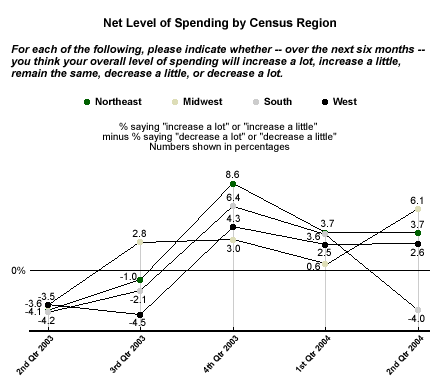Consumer spending intentions for the second half of 2004 suggest good things for retailers in the Midwest, but they may not bode well for those in the South. For retailers in the Northeast and the West, it looks like more of the same.
Consumer Spending Intentions
Over most of the past year, consumer spending intentions in all four regions of the country -- with the notable exception of the Midwest -- have followed a fairly similar pattern, increasing in the third and fourth quarters of 2003 and then tailing off in early 2004. Consumers in the Midwest were somewhat more optimistic than those in other regions during the third quarter of 2003 and less enthusiastic during the fourth quarter of 2003 and first quarter of 2004.
During the second quarter of 2003, consumers in all four regions expressed net negative spending intentions -- meaning that more consumers told Gallup that they planned to decrease their spending over the next six months than said they planned to increase spending. For example, in the second quarter of 2003, 22% of Southerners expected to increase their level of spending in the next six months, while 26.2% planned to decrease their level of spending. Therefore, consumer spending intentions in the South stood at –4.2%. But by the last quarter of 2003, consumers in each region were much more optimistic about their future spending. Consumers in the Northeast were most enthusiastic, with net positive spending intentions of 8.6%. The least optimistic were those in the Midwest, with a net positive percentage of 3.0%.
Consumer spending intentions declined in all four regions during the first quarter of 2004, but they diverged significantly during the second quarter. In the Midwest, net positive consumer spending intentions surged to +6.1% during the second quarter of this year -- the highest in any region. In sharp contrast, consumer spending expectations continued to plummet in the South, hitting –4.0% -- virtually the same pessimistic level as the second quarter of 2003. Consumer spending intentions in the Northeast and West remained essentially unchanged from their first quarter levels -- well above where they were a year ago.

Bottom Line
Gallup's economic measures show that overall, consumer confidence and investor optimism increased during June (see "Investor Optimism Surges Even as Inflation Fears Grow" in Related Items). Grouping the numbers by quarter, however, shows that consumer enthusiasm for the economy's prospects waned between the first and second quarters of 2004. The numbers also suggest that consumer spending intentions for the next six months differ significantly by region.
The strong performance of the manufacturing sector may help explain why consumers in the Midwest have shifted from being the least optimistic to the most optimistic about their future spending. Conversely, the movement overseas of textile production and other activities traditionally concentrated in the southern states may have had a disproportionately negative impact on consumer perceptions in the South. Also, today's much higher energy costs may have a significant negative impact on the South during the summer, similar to the strain they put on the North during the winter.
Regardless of the reasons for the divergence, these data on regional consumer spending intentions may be good news for retailers and small businesses in the Midwest, assuming residents there follow through with those intentions. Unfortunately, just the opposite is the case for consumer businesses operating in the South.
* Results are based on telephone interviews with 3,000 national adults interviewed quarterly between April 2003 and June 2004. For this sample of national adults, one can say with 95% confidence that the margin of sampling error is ±2 percentage points. For results based on the total sample of adults in the Northeast, Midwest, and West Census regions, one can say with 95% confidence that the margin of sampling error is ±4 percentage points. For results based on the total sample of adults in the South region, one can say with 95% confidence that the margin of sampling error is ±3 percentage points.
The U.S. Census Bureau defines its regions as follows: The Northeast region includes Connecticut, Maine, Massachusetts, New Hampshire, Rhode Island, Vermont, New Jersey, New York, and Pennsylvania. The Midwest region includes Illinois, Indiana, Michigan, Ohio, Wisconsin, Iowa, Kansas, Minnesota, Missouri, Nebraska, North Dakota, and South Dakota. The South region includes Delaware, District of Columbia, Florida, Georgia, Maryland, North Carolina, South Carolina, Virginia, West Virginia, Alabama, Kentucky, Mississippi, Tennessee, Arkansas, Louisiana, Oklahoma, and Texas. The West region includes Arizona, Colorado, Idaho, Montana, Nevada, New Mexico, Utah, Wyoming, Alaska, California, Hawaii, Oregon, and Washington.

